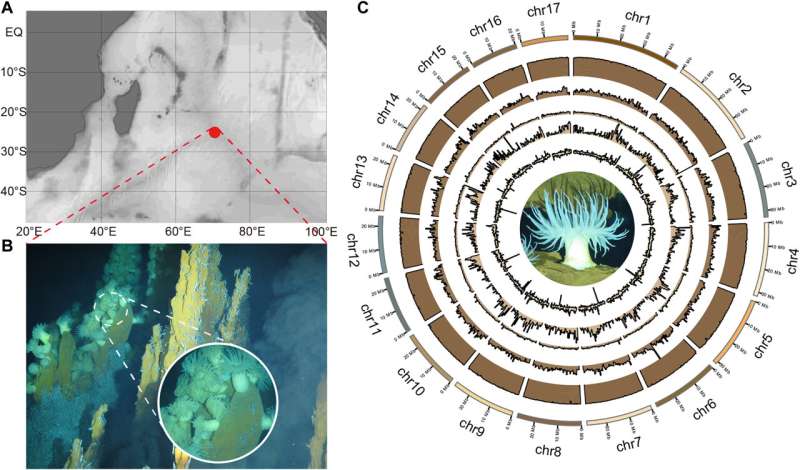October 27, 2023 report
Studying sea anemone genes to learn how they survive near deep-sea hydrothermal vents

Bob Yirka
news contributor

A team of deep-sea and environmental scientists affiliated with multiple institutions in China has learned more about how some sea anemones are able to live near deep-sea hydrothermal vents by studying the genes of one species: Alvinactis idsseensis sp. nov. In their research, in the journal Science Advances, the group conducted a genomic analysis of the creature and explored its ability to withstand the harsh conditions surrounding deep-sea hydrothermal vents.
Prior research has shown that a large variety of sea creatures have adapted to living near hydrothermal vents. Such adaptations have been necessary as conditions around such vents typically involve extreme pressure, complete darkness, high temperatures and toxic chemical emissions. Prior research has also shown that some of the most toxic materials spewed from vents include high concentrations of heavy metals such as manganese and iron. In this new effort, the research team sought to learn more about the physical characteristics of sea creatures that live under such conditions.
The researchers chose to focus their efforts on a single creature, A. idsseensi, a type of sea anemone that has come to dominate the seafloor around many ocean hydrothermal vents. As with other sea anemone, A. idsseensi is classified as a predatory animal—it feeds on blind shrimp that have also evolved to survive in the harsh environment. The research team obtained samples of the anemone collected by the mini-sub Shenhaiyongshi back in in 2019 while studying the seafloor in the southwest Indian Ocean.
In their analyses of the anemone genome, the researchers found it had 13 mitochondrial permeability transition (MTP) genes. These have been found in other organisms, such as another type of sea anemone that lives in shallow water, though it only had one. Such genes have been found to assist in metabolizing metals by detoxifying them. Thus, having a lot of them would make sense for an organism that lives in a place with high levels of heavy metals.
To learn more about how the genes protect the anemone, the research team added two of them to the genomes of yeast samples and found that doing so protected the yeast against metal poisoning when they were exposed to high amounts of manganese.
Written for you by our author —this article is the result of careful human work. We rely on readers like you to keep independent science journalism alive. If this reporting matters to you, please consider a (especially monthly). You'll get an ad-free account as a thank-you.
More information: Yang Zhou et al, Genetic adaptations of sea anemone to hydrothermal environment, Science Advances (2023).
Journal information: Science Advances
© 2023 Science X Network


















